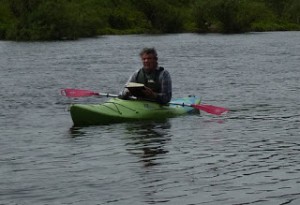 I’ve been cramming quite a number of adventures in lately (most of them involving a thorough wetting!), leaving me precious little time to blog, and there’s so many more lined up it’s going to be difficult keeping up any narrative. A couple of weeks ago I kayaked down the Wye with my daughter Catherine and her partner Nicko, and she took this shot of me sketching in calm water. The scowl, if you can see it, is obligatory when sketching if you need clear concentration – lose your paddle and all you have to operate the craft with is a number ten round sable……. It was a marvellous day out, in glorious sunshine.
I’ve been cramming quite a number of adventures in lately (most of them involving a thorough wetting!), leaving me precious little time to blog, and there’s so many more lined up it’s going to be difficult keeping up any narrative. A couple of weeks ago I kayaked down the Wye with my daughter Catherine and her partner Nicko, and she took this shot of me sketching in calm water. The scowl, if you can see it, is obligatory when sketching if you need clear concentration – lose your paddle and all you have to operate the craft with is a number ten round sable……. It was a marvellous day out, in glorious sunshine.
 One of the problems we have as artists painting in the landscape, is the need sometimes to fill a gap – perhaps to replace a rather boring or unpleasant object. In this painting of a scene in the Brecon Beacons I have added in a clothes- line on the left of the building to replace some unremarkable bushes. This is an excellent way of adding interest and colour to a farm or cottage. The horse was actually there and didn’t need any changing at all.
One of the problems we have as artists painting in the landscape, is the need sometimes to fill a gap – perhaps to replace a rather boring or unpleasant object. In this painting of a scene in the Brecon Beacons I have added in a clothes- line on the left of the building to replace some unremarkable bushes. This is an excellent way of adding interest and colour to a farm or cottage. The horse was actually there and didn’t need any changing at all.
The actual painting is in the Ardent Gallery in the centre of Brecon, together with several other of my watercolours – telephone 01874 610710

